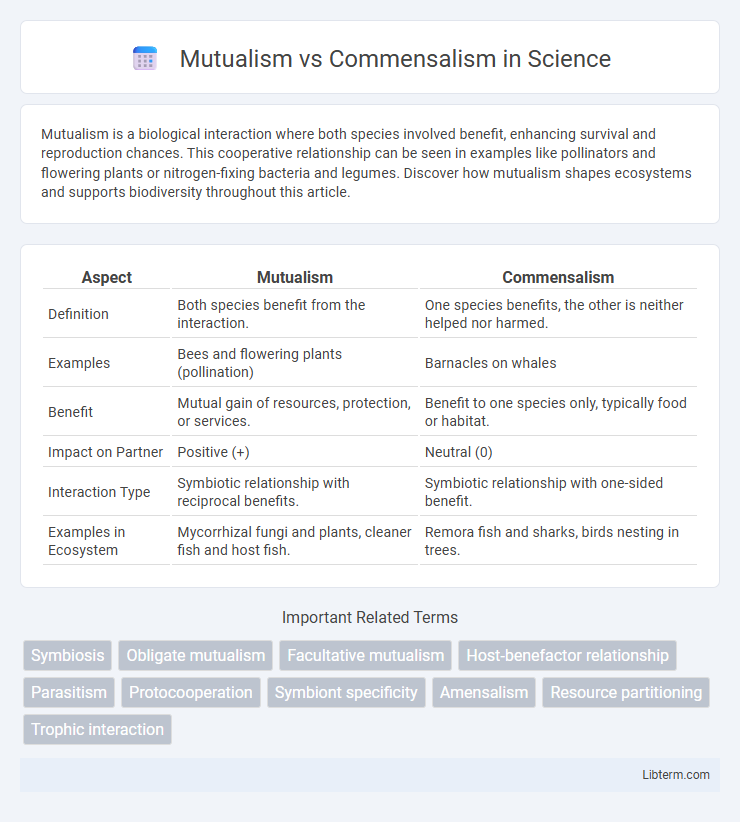Mutualism is a biological interaction where both species involved benefit, enhancing survival and reproduction chances. This cooperative relationship can be seen in examples like pollinators and flowering plants or nitrogen-fixing bacteria and legumes. Discover how mutualism shapes ecosystems and supports biodiversity throughout this article.
Table of Comparison
| Aspect | Mutualism | Commensalism |
|---|---|---|
| Definition | Both species benefit from the interaction. | One species benefits, the other is neither helped nor harmed. |
| Examples | Bees and flowering plants (pollination) | Barnacles on whales |
| Benefit | Mutual gain of resources, protection, or services. | Benefit to one species only, typically food or habitat. |
| Impact on Partner | Positive (+) | Neutral (0) |
| Interaction Type | Symbiotic relationship with reciprocal benefits. | Symbiotic relationship with one-sided benefit. |
| Examples in Ecosystem | Mycorrhizal fungi and plants, cleaner fish and host fish. | Remora fish and sharks, birds nesting in trees. |
Understanding Mutualism and Commensalism
Mutualism and commensalism are two key types of symbiotic relationships that describe interactions between different species. Mutualism benefits both organisms involved, such as bees pollinating flowers while receiving nectar, whereas commensalism benefits one organism without harming or benefiting the other, like barnacles attaching to whales. Understanding these relationships is crucial for ecological studies, highlighting how species coexist and influence ecosystem dynamics.
Key Differences Between Mutualism and Commensalism
Mutualism involves a symbiotic relationship where both species benefit, such as bees pollinating flowers while obtaining nectar. Commensalism benefits one species without affecting the other, exemplified by barnacles attaching to whales for transportation without harming the host. The key difference lies in mutual benefit versus neutral impact on one partner, highlighting ecological interactions and species dependencies.
Types of Mutualistic Relationships
Mutualistic relationships include obligate mutualism, where both species depend entirely on one another for survival, such as the yucca plant and yucca moth. Facultative mutualism occurs when species benefit from each other but can survive independently, exemplified by cleaner fish and client fish. Another type is trophic mutualism, involving nutrient exchange like the association between mycorrhizal fungi and plant roots.
Examples of Mutualism in Nature
Clownfish and sea anemones exhibit mutualism where the clownfish gains protection from predators while cleaning the anemone. Bees and flowering plants engage in mutualism as bees collect nectar for food and simultaneously pollinate the flowers, facilitating plant reproduction. Mycorrhizal fungi form mutualistic associations with plant roots, enhancing nutrient absorption for the plant while receiving carbohydrates in return.
Types of Commensal Relationships
Commensalism exhibits diverse types of relationships such as phoresy, where one organism uses another for transportation without harm; inquilinism, involving one species living within the habitat of another; and metabiosis, where one organism benefits from the remains or byproducts of another. Mutualism, by contrast, entails reciprocal benefits for both organisms involved, fostering cooperative interactions that enhance survival, unlike the neutral impact on the host found in commensalism. Understanding these distinct ecological interactions highlights the complexity and diversity of species interdependence within ecosystems.
Examples of Commensalism in Ecosystems
In ecosystems, commensalism is exemplified by barnacles attaching to whales, where barnacles gain mobility and access to food particles without harming the whale. Epiphytic orchids growing on tree branches benefit from increased sunlight exposure while the host tree remains unaffected. Another example includes cattle egrets following grazing animals to feed on insects stirred up by their movement, gaining food without impacting the grazers.
Ecological Impacts of Mutualism
Mutualism drives ecosystem stability by promoting biodiversity through reciprocal benefits between species, such as pollinators aiding plants in reproduction while obtaining nectar. This interaction enhances nutrient cycling and resilience against environmental disturbances, strengthening community dynamics. Mutualistic relationships contribute to ecosystem productivity by supporting population growth and facilitating resource distribution across trophic levels.
Ecological Impacts of Commensalism
Commensalism influences ecosystems by supporting species diversity without harming host organisms, often facilitating habitat complexity and resource distribution. This interaction enables commensal species to benefit from shelter, transport, or food sources, enhancing survival and reproduction rates while maintaining ecological balance. Such dynamics contribute to ecosystem stability by promoting interspecies relationships that do not disrupt existing population or resource cycles.
Factors Influencing Symbiotic Relationships
Mutualism and commensalism are influenced by factors such as resource availability, environmental conditions, and the evolutionary adaptations of the species involved. In mutualism, both species benefit through reciprocal exchanges like nutrient sharing or protection, driven by genetic compatibility and ecological niches. In commensalism, one species gains advantage without harm to the host, often facilitated by habitat structure or behavioral traits that enable coexistence without direct competition.
Importance of Mutualism and Commensalism in Biodiversity
Mutualism and commensalism play critical roles in maintaining biodiversity by promoting species interactions that enhance ecosystem stability and productivity. Mutualistic relationships, such as pollination between bees and flowering plants, facilitate genetic diversity and reproductive success, while commensalism allows certain species to benefit from others without harm, supporting niche differentiation and species coexistence. Both symbiotic interactions drive ecological balance and resilience, making them essential components for sustaining diverse biological communities.
Mutualism Infographic

 libterm.com
libterm.com